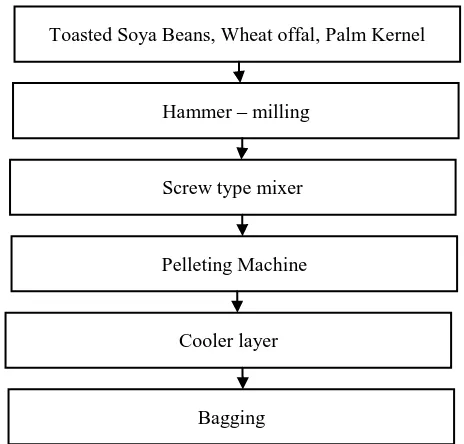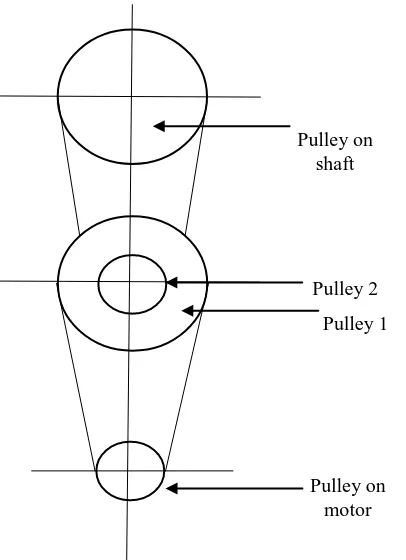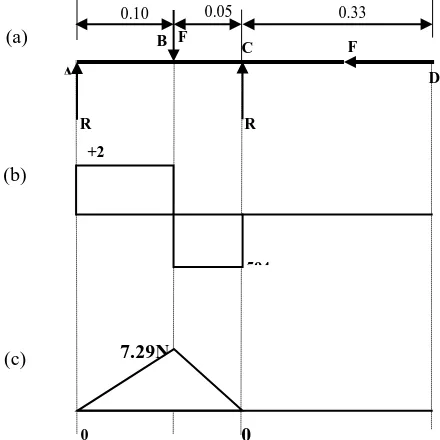ISSN: 2231-5381
http://www.ijettjournal.org
Page 168
Design, Construction and Testing of a Poultry
Feed Pellet Machine
O.A. Olugboji
1,
M.S. Abolarin
2, M.O. Owolewa
3, K.C. Ajani
*4Department of Mechanical Engineering, School of Engineering and Engineering Technology, Federal University of Technology, P.M.B 65, Minna, Nigeria
Abstract
—
With increasing emphasis on self-employment as a means of improving the standard of living, there is consequently a diversification of human occupation notably in the agro-allied industries. Fish-feed machines are therefore important for the production of pelletized feed. This paper presents the design, fabrication, development and testing of a cheap, electrically operated feed pellet machine with locally available materials. The basic dimensions of the parts obtained by design calculation. Two horse power electric motor was used to drive the machine. The experimental work was carried out by testing the machine and the operation capacity was found to be 5kg/hr.Keywords— Design, Testing, Poultry feed, Pelletizing, Pellet
making machine.
I. INTRODUCTION
This document is a template. An electronic copy can be downloaded from the conference website. Poultry feed pelletizing machine is the machine used in the turning of fish feeds into pellet form. More emphasis are laid on the agricultural sector as a veritable self-employment tool, a means of improving the standard of living and a means of improving the technological challenges inherent globally in the sector. Hence, the need for diversification of human occupation in the area of agro-fish business. For the continual upkeep of this business, fish-feed machines of various kinds are important.
Pelletizing can simply be described as the change in phase of raw materials due to the application of medium to raise the temperature in order to have a final phase in a solid and capsular form after passing through the die of desired shape. It results from a combination of the heat treatment during extrusion, moisturization and gelatinization of some dietary components, which act as binder. The binding effect prevent nutrient loss by slowing down the pellet disintegration process in water. [1]
Most fish farmers are faced with the difficulties in producing pelletized feed, mostly for the fingerlings fishes. They resort to using meat grinder, or cutting the pellet strands with knife. Also, most feed compounding machines available have a limitation of not being pelletized due to the presence of much water without an effective dehydration mechanism. These kind of methods are time and energy consuming and this leads to low production.
This paper presents the production of an economical fish feed pelletizing machine designed to alleviate the above problems .Poultry (fish) feed pelletizing machine which could be manually or electrically operated, was designed and
constructed. The major components includes the hopper, barrel, pelletizing die, suitable bearing, belt, conveyor belt. The ingredients of the fish feeds are thoroughly mixed to dough or paste form before being paired into the machine depending on the die shape.
II. MATERIALS AND METHODS
A. Design materials and equipment
The important factor to be considered in material selection were employed to determine the suitable material [2]. Mild steel was selected, because of the cost effectiveness, availability and easy workability, the barrel was constructed by using a stainless steel.
To obtain good finishing and accuracy, various tools and machines were employed during the fabrication of the machine. They include the lathe machine, welding machine, drilling machine and bench work tool. The feeding Hopper was constructed by cutting 3mm thick mild steel into fine trapezoidal plates and the edges welded together. The shaft and screw conveyor are made of mild steel rod turned to 25mm diameter. The barrel is made of a 74mm diameter stainless steel pipe and the length 305mm cut out of a large pipe. It houses the screw conveyor. The frame with height 510mm, breadth 240mm and with 400mm width made of steel was cut using hacksaw and welded together. The disk plate attached to the barrel. The barrel is a circular component made up of twenty-eight holes of 3mm each through which the turned feeds extend through in pellet form.Mild steel hasfound applications in various other locally available fabricated machines[3].
B. Fish Feed Composition
Fish farming is a tedious and difficult operation because more than half of the operation time is spent in taking good and adequate care of the need of the fish, especially feeding [4]. A compound diet of feed entails a combination of nutrient source to meet the nutrient requirement of fingerlings. This feed is fortified with all the nutrient required by fish. This is used intensively in aqua-culture system where there is complete dependence on artificial feed for sustenance. The basic knowledge of the available feed ingredient and their respective nutrient, the nutrient requirement particularly of the fingerlings in question and processing techniques and equipment [5].
ISSN: 2231-5381
http://www.ijettjournal.org
Page 169
factors influenced the choice and compounding of the rawmaterials used. These include toasted soya beans, wheat offal, palm kernel. Temperature has great role to play in pelletizing of the feed. The water is raised to temperature of about 80 – 1000C at which the steam is being generated using a heater close to the barrel. The steam is used as a binder binding the feed together in a capsules structure. It reduces fatigue and stress of mixing the feed manually and the stress carrying the mixture before passing it into the hopper, it further increases the final quality of the output.
Fig. 1Schematic Diagram of stages in poultry (fish) feed production.
III.THEORETICAL ANALYSIS
A. Determination of Axial Force needed for extruding Let effective area of baffle = AC,
Output Area of die = A0 = ½ AC diameter of barrel
db = diameter of shaft = ds.
Then, 1
Therefore axial force = 2 Where P = extruding pressure
B. Determination of the screw’s conveyor’s press Torque Assuming a 95% conveying efficiency, the torque
can be
determined by the relation 3 Where = pitch length [5]
The Equation for the determination of the extrude power 4 Also, the thickness of Barrel,
[6]
5
Fig. 2 A Cross section of barrel and Shaft assembly.
C. Determination of Pulley Diameters Due to the relatively slow speed of rotation in the screw
conveyor shaft that need to conserve space, a two-stage pulley drive is to be used. Therefore, the two drive pulley are set to be equal. The diameter of the pulleys as shown in Fig. 3 are determined from the relation
6 6
7
The variables D1 and Ds are the diameters on the pulley 1
and the pulley on the shaft respectively while Dm and D2 are
the diameters of pulley on motor and on pulley 2, Nm, N1, Ns
and N2 are the speed of the motor, driven pulley, shaft and
driver pulley respectively.
D. Determination of Tensions on Belt
The intermediate shaft and the conveyor shaft have identical drives. Therefore, the same analysis as well as calculation stand for both devices. The relationship for a vee belt between tensions in belt is express as
[7] 8
Where T1 and T2 represent the tension on the lighter side, the
weaker side and the belt respectively.
µ is the coefficient of friction between belt and grove sides of pulley,
θ is the angle lapped by belt on driven pulley and β is the half of the grove angle.
9 For a pulley, Torque transmitted 10 Where R is radius of pulley,solving equations 9 and 10,
11 12 E. Determination of the Diameter of Shafts
The intermediate shaft is subjected to combined torsion and bending moments, and the diameter is obtained on the basis of strength from the reaction
13
d is the diameter of shaft, M and T are the maximum bending and Torsional moment, σmax maximum allowable shear stress,
Kt and Km are the combined shock and fatigue factor for
Ød
s Ødbt
Øds
Toasted Soya Beans, Wheat offal, Palm Kernel
Hammer – milling
Screw type mixer
Pelleting Machine
Cooler layer
ISSN: 2231-5381
http://www.ijettjournal.org
Page 170
bending and torsion. Consequently, the screw conveyor shaftwhich is axially loaded in this case with a combination of bend loading and torsional loading, the diameter of the shaft is obtained from the relation
14
Where M, T and d are as stated for equation above and ηmax is
maximum bending moment and F is the axial force.
Fig. 3 Section of belt, pulley and shaft arrangement.
F. Determination of heat needed to raise the temperature. The medium of temperature depends in the raw materials which is to be pelletized; for example, heater land control via panel may be connected directly on the external part of the barrel, which will be used in conveying iron steel [1]. Also steam may be used in the barrel conveying fish feed. The purpose of the high temperature medium is to change the raw materials from solid state to semi-solid state for easy transportation by the screw conveyor and also to form the required pellet or shape.
IV.DESIGNCALCULATION A. Calculation of axial force needed for extruding
From equation 1 db and ds was found from calculation to be
0.074m and 0.025m respectively. The area was found to be 190X10-3m2. The axial force was arrived at by using equation 2, with the maximum pressure was taken to be 9.2N/mm2[8]. The force is 17525.86N
B. Calculation of screw conveyor’s Torque to press
The screw conveyor requires a torque of 117.152Nm. This value was derived from the relation in equation 3. This means that the stated value of the torque is required in order for the conveyor belt to be driven.
C. Calculation of Tensions on the in Belts
The schematic representation of the loads, shear force and bending moment acting on the intermediate shaft is as shown in Fig. 4. The forces at point B and C were calculated to be the same.
Fig. 4a, b and c. schematic representation of the loads, shear force and bending moment
The values of forces at point A RA was calculated as 99N. This is
arrived at by taking moment about the point D in Fig 4a. The force at point D, RD was also gotten as 99N by taking the
moment about point A. The share force diagram as shown in Fig. 4b represent the prevailing shear forces across the shafts. This depicts that points B and C bordered the highest shear force because of the load impact at these regions. Lastly, Fig. 4c, gives the bending moment prevalent at each point on the intermediate shaft. The value of the bending moment are minimum at both point A and D. while the maximum bending moment is found to be 7.92Nm at B and C.
The bending moment, shear force and load on the screw conveyor shaft was evaluated as represented by the figure 5 below.
RA F
C
FB RD
(a)
(b)
(c)
0.08 0.02 0.08
A D
C
B
+99N
891N -891N
-99N
+9.92Nm
0 0
-7.92Nm Pulley on
shaft
Pulley 2
ISSN: 2231-5381
http://www.ijettjournal.org
Page 171
Fig. 5a, b and c. schematic representation of the loads, shear force and bending moment.
As shown in the diagram, the various loading on the screw conveyor shaft is represented as the load diagram and the load of RA and RC were calculated to be 297N and 594N
respectively. These were gotten by taking moment about the point C and A. Fig. 5b, Shows the shear force acting along the screw conveyor shaft with a shear of 594N being the
maximum. This increase in shear force is as a result of the downward force FB.
The bending moment on the shaft is as represented by the Fig. 5c, with the maximum bending moment on the screw conveyor shaft as 7.29Nm at point B. The Bending moment at A and C is equal to zero because there are no transverse force acting between points C and D. only axial force is present and the weight of the pulley is negligible
D. Calculation of diameter of shafts
The diameter d of the intermediate shaft is determined using the equation 13. The value gotten was 0.02774m and the standard shaft size of 28mm was used for the intermediate shaft.The diameter of the screw conveyor shaft was calculated to be 0.025m using the equation 14. The maximum shear stress ( max) gotten from the use of this diameter is
47.08X106N/m2, which is below the allowable shear stress of 50 X106N/mm2 for the mild steel chosen. Thus, validating the adequacy of using 25mm diameter
E. Calculation of the power of electric motor P =
Where P= power, T= torque = 14.48Nm W= angular velocity
= W= 150.796 rad/sec P= 14.48 ×150.796 = 2237.8 W
F. Determination of belt tension and torque
The power transmitted by the electric motor is known to be P= 2237.8 W
Efficiency of supply = 80% [9] T= 0.8 × 2237.8
T= 1790. 24 W. Service factor = 1.4 [5]
V. RESULTS Experimental Results
Adequate amount of feed was mixed with a proportionate amount as the binder. The weight of the feed to be pelleted was noted and the record was taken to be 0.5kg. The time taken to pellet the feed was also recorded using the stop-watch so as to determine the capacity of the machine and this time is 6minutes. The capacity of the machine per hour therefore is evaluated by the relation
.
Fig. 6 A cross section of pellet making machine.
VI. DISCUSSION
The main features of the machine are as shown in Fig.6 are the hopper, pulley, supporting frame extrusion barrel, bearing housing, the knife cutter. The experimental test was done by mixing various ingredients thoroughly into paste form using water as binder and was then feed into the hopper. The machine was then set to gyration. This extended through the extending holes of the die plate and was cut to desired sizes by the cutting mechanism.
Proportionate mixture of the water and the ingredients to avoid watery compaction. It was also discovered that Inconsistent mixture of the ingredients may lead to a sticky product and as such the pelletized feed breaks before getting the desired sizes. That is with excess water it turns sticky and with less water the extended feed become too hard.
VII. CONCLUSION
The poultry (fish) feed pellet machine was fully developed putting much factors together. The result obtained showed that
0.10 0.05 0.33
A
R
A
R
C
D F
B C F
B
+2 97 N
594 N
7.29N m
0
0 (a)
(b)
ISSN: 2231-5381
http://www.ijettjournal.org
Page 172
the machine’s capacity is 5kg/hr and the feed were wellpelletized. The production of the machine will aid meet the rising needs of poultry and fish production as a means of boosting the food production capacity. The machine was produced in an economical method as the cost analysis of the machine is cheap.
REFERENCES
[1] P. Fellows (1998) Food Processing Technology, Ellis Horword.
[2]Khurmi R.S, Gupta J.K 2006 a textbook of workshop technology by SChand and companyltd.
[3] Okegbile O. J., Mohammed A., Hassan A. B., Obajulu O. (2014). Fabrication and Testing of an Improved Hydraulic Accumulator for a truck loading lift,International Journal of Engineering Trends and Technology (IJETT),Vol. 10 No.12, 586-589.
[4]J.E. Igbmosun, O.O. Roberts, Binder in fish feeders (Technical Report). Fish feeds and their application in ponds extension guide No 3 (Aquaculture Development)
[5] U.U. Gabriel, O.A. Akinrotimi, D.O. Bekibele., D.N.Onunkwo,P.E. Anyanwu, (2007),Vol.2(7),pp. 290-292. Locally produced fish feed
[6] J.E. Shigley and C.R. Mischike (1989): Mechanical Engineering design 5th
edition by McGraw- hills
[7] R.S. Khurmi and G.H. Gupta (2006): A textbook on Machine design 2nd
edition S Chand and Company.
[8] M.V Joshi (1981) Process Equipment design 2nd Edition


